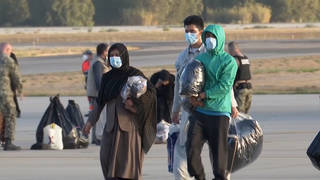
Topics
As world attention remains riveted on the Occupied Territories, the war in Afghanistan rages on. Just yesterday Britain announced that it had launched a major military offensive in the eastern mountains of Afghanistan, joining US and Afghan forces already deep in the region. Last month, the US launched “Operation Anaconda” in Afghanistan. It was the largest American-led ground offensive since the Gulf War and it lasted 12 days. Smaller assaults have continued throughout the past few weeks. According to CNN, fierce firefights erupted over the weekend between US soldiers and alleged Al Qaeda forces.
Meanwhile, the press has also been reporting increased fighting between rival Afghan factions. Last week, the forces of an interim government commander and a royalist warlord clashed just west of Kabul, exchanging fire and killing at least three people. The fighting followed days after an assassination attempt in Jalalabad against Defense Minister Mohammad Fahim; Fahim survived the attack, but five others were killed and fifty were wounded. Just a week earlier, the Afghan government announced that it had unearthed a plot to kill interim leader Hamid Karzai and ex-King Zahir Shah. The government publicly blamed the Taliban and al-Qaeda for the plot, but also cast suspicion on a former Prime Minister and several powerful warlords. At least 160 people have been arrested in connection with the scheme.
The mounting instability in Afghanistan comes as the country begins the complicated and lengthy process of choosing a new government. On Monday, Afghans across the country began selecting representatives for the loya jirga, or grand council, that will convene in June to choose the new leaders. But with the rising tide of internal violence, many are concerned that the loya jirga will be severely undermined. A report recently released by Human Rights Watch describes a post-bombing Afghanistan racked by instability and factionalism.
Guests:
- Vikram Parekh, researcher with Human Rights Watch, who helped write the recently released report, “Paying for the Taliban’s Crimes: Abuses Against Ethnic Pashtuns in Northern Afghanistan.” [The 56-page report documents cases of summary executions, beatings, sexual violence, abductions, and looting that have been committed since November 2001, when non-Pashtun Northern Alliance forces regained power in the north.]
- Shazeia, member of the Revolutionary Association of the Women of Afghanistan (RAWA), speaking from Pakistan.
- Sonali Kolhatkar, vice president, Afghan Women’s Mission, and now KPFK’s morning show host and co-producer. She has an upcoming article in Berkeley Women’s Law Journal on the impact of US intervention on Afghan women’s rights.
Related link:
On Monday, four US soldiers were killed and one wounded trying to destroy a cache of rockets. The incident brings the number of U.S. troops killed in and around Afghanistan since the war began to 36. More than 3,000 Afghans have lost their lives in the US bombing; countless others have been killed or severely wounded by unexploded cluster bombs and mines. Estimates of the number of land mines and unexploded bombs and shells littering Afghanistan range from 600,000 to 10 million.
Guest:
- Hadi Ghaemi, independent researcher with the Center for Economic and Social Rights (CESR). He has just helped complete a report on Human Rights and the reconstruction of Afghanistan, expected to be released later this week. He is also working on a film based on footage. A portion of the film that we will be seeing today is called “Cluster Bombs: Theory vs. Experiment.”
Related link:












Media Options